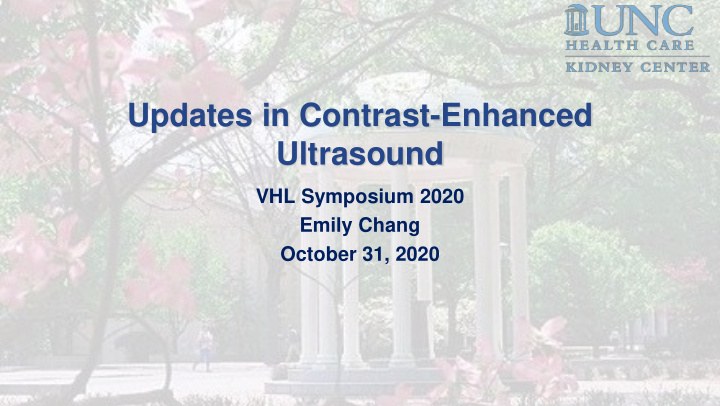



Updates in Contrast-Enhanced Ultrasound VHL Symposium 2020 Emily Chang October 31, 2020
Disclosures • Contracts with Lantheus Medical Imaging (makers of Definity, ultrasound contrast agent) 11/5/2020 2
Objectives • Rationale for investigation • Review of contrast-enhanced ultrasound (CEUS) Update in CEUS policies • Clinical CEUS procedure • » Clips • CEUS as surveillance in VHL? » Challenges » Benefits » Clips CEUS pancreas • 11/5/2020 3
Active Surveillance Changes (Borrowed from Dr Daniels’ slides) VHL.org 11/5/2020 4
Gadolinium - safety issues • Gadolinium very low adverse event rate • 2006: Nephrogenic sclerosing fibrosis reported in patients with severe kidney disease • Stage 4 and higher kidney disease requires informed consent -> RARE! • “Group 2” agents thus far no reports of NSF Woolen, et al. JAMA IM , Dec 2019 11/5/2020 5
Gadolinium – safety issues • 2015: Gadolinium deposition disease reported, but clinical significance not clear • 2017: FDA issues class warning » no direct linkage to adverse effects » requires New Patient Medication Guide » requires manufacturers to conduct animal and human studies to further assess safety 11/5/2020 6
Borrowed from Dr Sven Glasker’s slides 11/5/2020 7
Gadolinium – comfort issues • Long exam • Cumbersome • Loud noises • Cold/Hot • Personal experience: more difficult as I age • Cost $$$ 11/5/2020 8
Ultrasound Advantages Disadvantages • Accessibility • Single organ imaging • Cost • User dependent • Patient tolerability • Despite better resolution, • Lack of radiation interpretation is not intuitive to clinicians • Lack of contrast 11/5/2020 9
Contrast-enhanced Ultrasound (CEUS) • Microbubble contrast agents • Blood flow & tissue perfusion • Advantages: cost efficient, safe, images in real time • Disadvantages: Not yet FDA approved for kidneys, short enhancement and circulation time, single plane 11/5/2020 10
Sulfur hexafluoride Perflutren lipid lipid microspheres microspheres Lumason (Sonovue) Definity Perflutren protein microspheres Optison 11/5/2020 11
What makes Microbubbles Different from Gadolinium (or iodinated contrast) • Nonlinear response to ultrasound not produced by tissue » Microbubble echoes can be separated from tissue • No extravasation » Reflect blood flow • Can be destroyed with ultrasound – FLASH » Bubble signal can be cleared and reperfusion visualized 11/5/2020 12
Microbubble clearance • After minutes of circulation, breathed off • NOT cleared through the kidney • NOT nephrotoxic 11/5/2020 13
Update in CEUS 11/5/2020 14
CEUS indications/applications grow • Liver • Kidney (mass and in place of VCUG) Acute coronary syndrome • Vascular • • GI • Pregnant women! • Brain Pancreas • 11/5/2020 15
Billing PROCEDURE BASE CODE CHARGE ADD-ON CHARGE ADD-ON CHARGES PHARMACY CHARGE 76978 76979 76705 Q9950 for MLs used Lesion CEUS Ultrasound, targeted dynamic microbubble Ultrasound, targeted dynamic Ultrasound, abdominal, real time with image documentation; sonographic contrast characterization (non- microbubble sonographic contrast limited (eg, single organ, quadrant, follow-up) Q9950- with JW cardiac); initial lesion characterization (non-cardiac); -Liver modifier for MLs each additional lesion with discarded separate injection 76775 Ultrasound, retroperitoneal (eg, renal, aorta, notes), real time with image documentation; limited -Kidney(s) 76770 Ultrasound, retroperitoneal (eg, renal, aorta, notes), real time with image documentation; complete -Kidneys/Bladder
What Can the Patient Expect? 11/5/2020 17
CEUS process at UNC • IV: 20g or larger, preferably in larger AC vein • Localizing images • Pre-scan images reviewed with radiologist and sonographer • Real-time imaging 11/5/2020 18
Timing • IV placement to IV d/c: 1 hr Actual imaging: 5-20 min • • Time to result: Same day 11/5/2020 19
Case #1 • 51 yo man with ESKD on PD for 2 years, and recently started on HD • Minimal urine 3 cm L kidney mass seen on B-mode US •
CEUS
“Peak Hold”
Case #2 • 63 yo woman with PCKD • H/o partial L nephrectomy for RCC with resultant stage 4 CKD Referred for concerning CT scan •
CEUS – B-mode sweeps
Lesion 1
Lesion 2
Case #3 – Liver imaging in a CKD patient • 42 yo woman with FSGS and TB kidney • Incidental finding on MRI – hepatic lesion Cr 3-3.5, eGFR 13-18 •
CEUS
CEUS for VHL surveillance? Challenges Benefits • Usually a targeted study • No gadolinium or iodinated contrast exposure (safe if • Not been studied as a CKD) surveillance tool • Cheaper User dependent • Well-tolerated • Not all centers can do it • Excellent sensitivity with • • Single organ imaging adequate training 11/5/2020 29
CEUS VHL study at UNC • Unable to convert DICOM to viewable clip 11/5/2020 30
Pancreas? • In order to be truly effective, will need to be able to assess pancreas too D’Onofrio, European Journal of Radiology 2015 11/5/2020 31
Conclusion • CEUS shows promise as a surveillance tool for kidney lesions • VHL is a ideal disease in which to test this • May reduce exposure & cost and increase tolerability » Plan to assess patient satisfaction • Positive findings in this area have potential to increase CEUS applications 11/5/2020 32
Acknowledgements • Rachel White • Kennita Johnson • Terry Hartman • Shanah Kirk • Katie Johnson • Luna Hilaire (Lantheus) 11/5/2020 33
Thank you for your time! • Questions? • Emily_chang@med.unc.edu • @kimchikidney 11/5/2020 34
Ultrasound contrast agents • microbubbles gas core • • highly compressible • stabilizing shell (lipid, albumin) 5 µ m • biocompatible • Size: 1-5 microns, similar to RBC • activated by mixing • injected into bloodstream 2 µ m
Recommend
More recommend